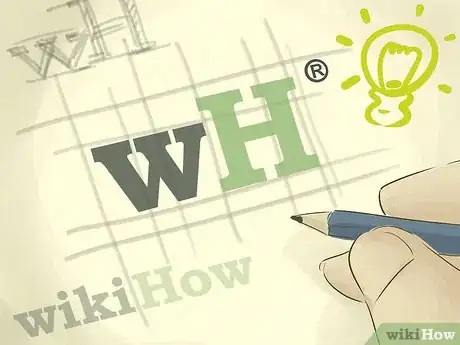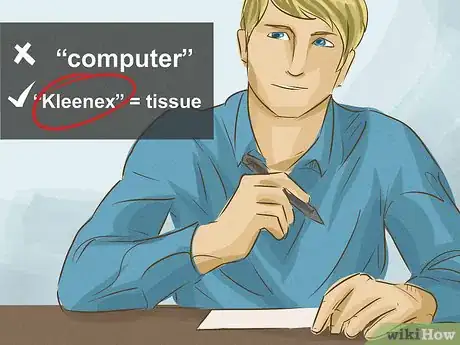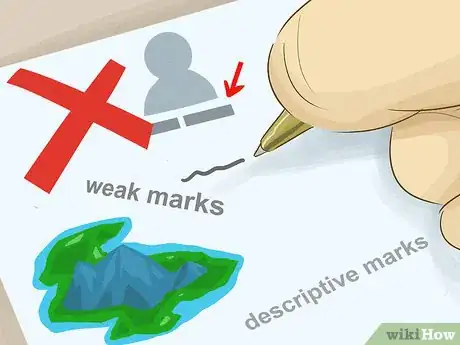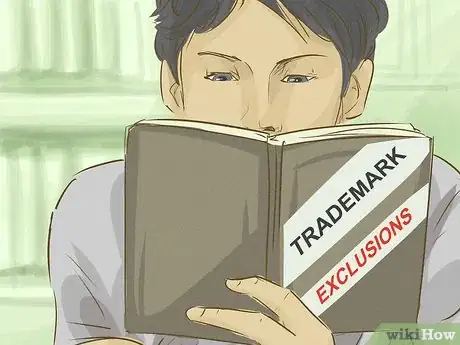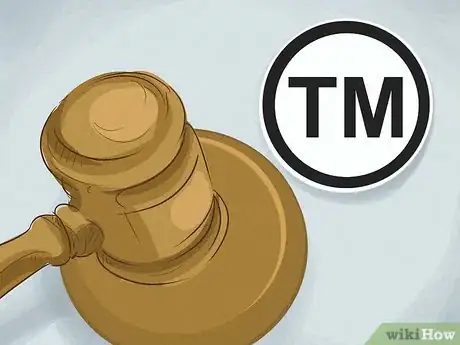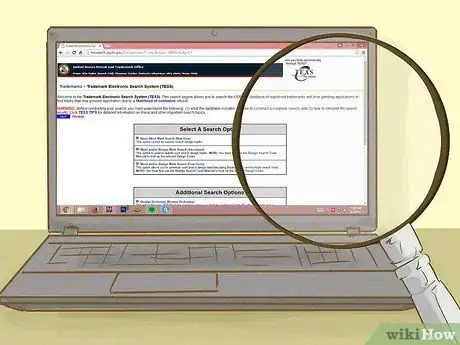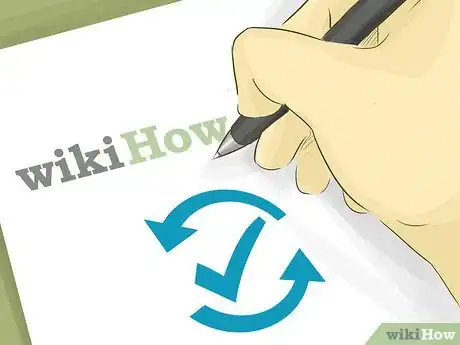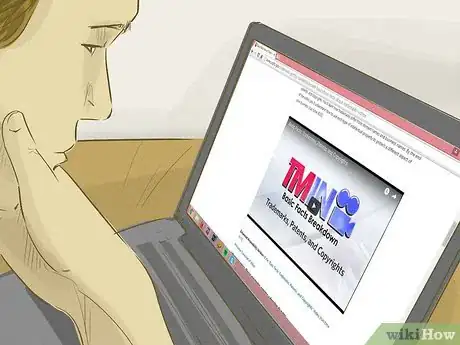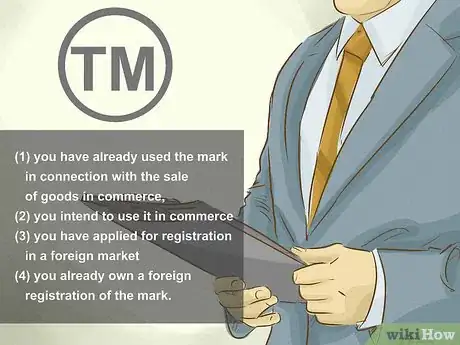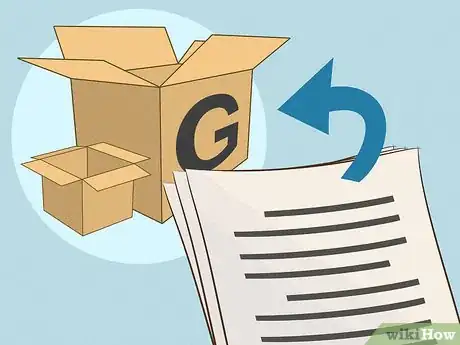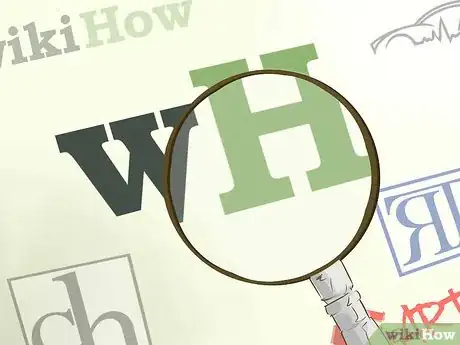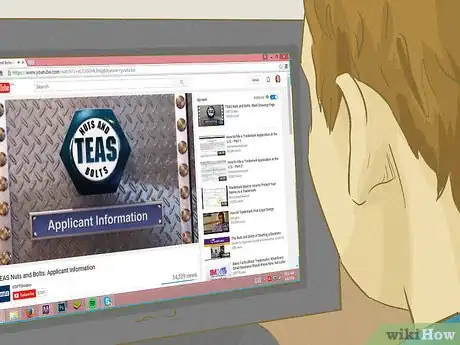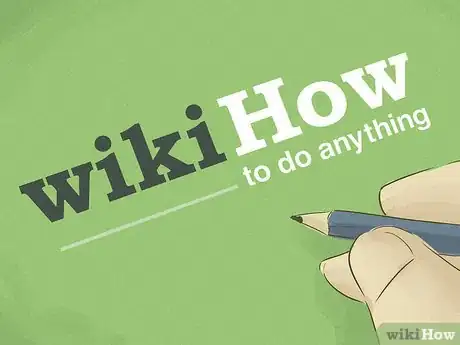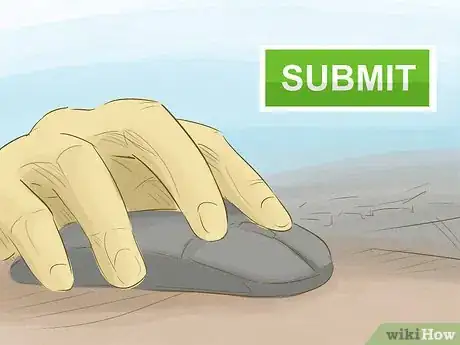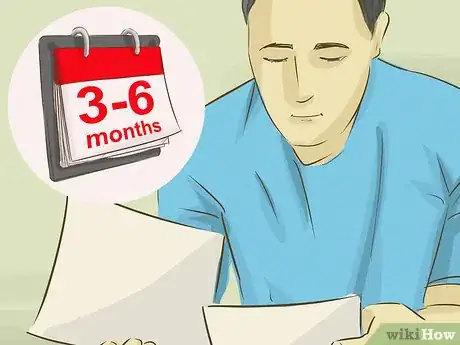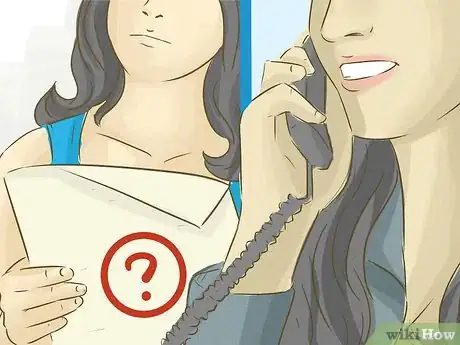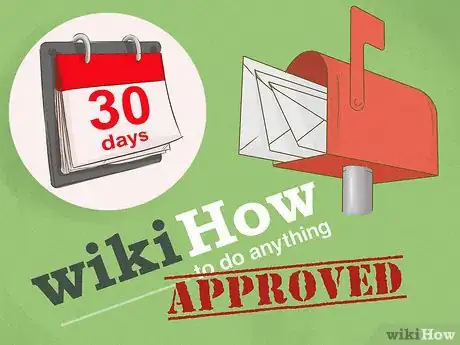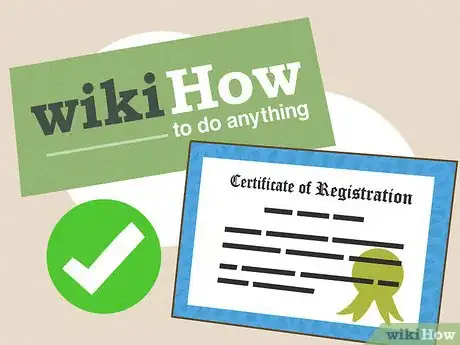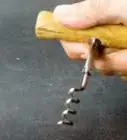This article was co-authored by Clinton M. Sandvick, JD, PhD. Clinton M. Sandvick worked as a civil litigator in California for over 7 years. He received his JD from the University of Wisconsin-Madison in 1998 and his PhD in American History from the University of Oregon in 2013.
There are 11 references cited in this article, which can be found at the bottom of the page.
wikiHow marks an article as reader-approved once it receives enough positive feedback. In this case, several readers have written to tell us that this article was helpful to them, earning it our reader-approved status.
This article has been viewed 74,653 times.
A trademark protects a word, phrase, symbol, or design associated with your business service or product name from being used by someone else. It does not protect an idea, as a patent does, or the expression of an idea, as copyright does. A registered trademark gives the owner better rights than one not registered. In order to register a trademark, you'll need to choose a distinctive mark that has never been used in your field before and file it with the United States Patent and Trademark Office. Once your mark has been accepted, you can more easily take legal action if someone else tries to pass it off as their own.
Steps
Deciding on a Trademark
-
1Sketch out ideas for a trademark. A trademark is a distinctive word, phrase, logo, graphic symbol or other device that is used to identify the source of a product or service and to distinguish it from competitors.[1] It can also include “trade dress”: other distinctive aspects of a product or service that tend to distinguish the product or service, such as shapes, letters, numbers, sounds, smells, or colors. Brainstorm ideas for a trademark for your product.
- Some examples of trademarks are Honda (for cars), Doritos (for chips), and McDonalds (for fast food).
- “Trade dress” includes distinctive colors on a FedEx envelope or the Olympic committee’s colored circles.
-
2Avoid disparaging terms. Offensive terms may not be registered as trademarks.[2] Words in a foreign language, if offensive, also cannot be registered as trademarks.Advertisement
-
3Avoid generic marks. Your trademark shouldn’t be generic.[5] A generic term describes an entire group or class of goods or services. For example, “computer” is a generic term because the public associates a generic term with a type of goods or services, not a particular brand.
- In some circumstances, a trademark will be so successful that it eventually becomes “generic”; that is, the general public believes that the trademark is actually the name of a class of goods. Classic examples include “Kleenex” for tissue and "escalator" for moving stairways. However, this is a problem you won’t face until down the road, when your product is so successful that it dominates the market.
-
4Avoid weak marks. Weak marks include descriptive marks, geographic marks, and marks that are last names. You cannot register a weak mark unless you can prove that consumers are aware of the mark and associate it with your product or service, giving it "secondary meaning".
- In other words, to register a weak mark, it would need to have been used for quite some time so that there is proof that it has become a distinctive brand.
-
5Avoid functional marks. A “functional feature” is generally something that is essential to the product or service and therefore is present in all goods or services of that type. A functional feature may not be registered as a trademark.
- For example, a product shape or product packaging can be seen as a functional feature. Although a product shape may be capable of being a trademark, it must not be utilitarian.[6]
- An example is having wheels on a car.[7] This feature cannot be protected as a trademark, because it is essential to how the product works.
- If there is a patent for the feature, then this is strong evidence that it is functional.[8]
- Apple was awarded a registration for the trademark shape of the iPod.[9] Apple was able to convince the USPTO that consumers associated the shape of the iPod with Apple.[10]
-
6Study other exclusions. There are many other exclusions. For example, a trademark cannot be a person’s full name or likeness if the person is not associated with the product. Other exclusions include:
- The mark is a geographical description of the origin of the goods or services, and you cannot prove that the location is associated specifically with your good or service.
- The mark is a translation of a foreign word that is generic or descriptive of the goods on which you are using it.
- The mark is already used for a book series or movie series title.
- The mark is pre-empted by state or federal laws, such as "Smokey Bear" or the US flag.
-
7Consider hiring a trademark attorney. An experienced trademark attorney can help you pick a successful mark. He or she will be well versed in what qualifies as a strong or weak mark and will be able to assist you in your search to find out whether the mark is already in use.
- A trademark attorney can also help you navigate the more complicated aspects of the application process and give you the best shot at getting your mark registered.
- If you decide to hire an attorney, be sure to find someone who has plenty of experience working with the USPTO. Trademark attorneys should list their experience on their website.
Revising the Trademark
-
1Search for similar marks. Once you have a rough idea of what you want your trademark to be, you can do an online search for the mark you have chosen. Use the Trademark Electronic Search System (TESS) on the USPTO website.
- Online searches of the Trademark Electronic Search System (TESS) database are free. You will need to consult the Design Code Search Manual for the right code to search for if the mark includes a design element.
- The main Trademark Public Search Library is in Alexandria, VA, and it is open weekdays, 8:00 a.m. to 5:30 p.m. Members of the public may use the library for free.
- Some information may be searched at a regional Patent and Trademark Depository Library. These libraries have CD-ROM databases of registered and pending marks, but these databases lack design mark images.
- Additionally, keep in mind that not all trademarks are located on the TESS system. You should also do a search of state trademarks (in the states where you plan to sell your product) and even foreign trademarks (if you plan to sell your product overseas). To see if your state registers trademarks, visit the USPTO’s link by clicking here.
- In the USA, Canada and several other countries, an existing non-registered trademark may also be enforced to prevent you from using or registering your brand, if it is too similar. You should search relevant materials in your field and related fields to detect the use of non-registered brands that may be similar to yours.
-
2Evaluate existing trademarks for possible conflicts. If an existing trademark looks similar to the one you're considering, use the TESS or the Trademark Status and Document Retrieval (TSDR) database to check its status. You'll need to know the mark's serial or registration number to search TSDR.
- Just because there may be a similar or identical brand in use or even registered, that does not mean it is automatically off limits. However, it will undermine the distinctive value of your brand, if not also create a negative "copycat" perception within your own market.
- It is not unusual to see "identical" brands used or even registered simultaneously by different businesses in unrelated markets or locations.
-
3Revise the mark. If you find a mark that is similar to yours in a related field, you may need to revise yours to make it more distinctive or simply select a different mark. A mark that is “confusingly similar” to an existing registered mark will not be registered.[11]
- A confusingly similar mark is one that will create a "likelihood of confusion" among consumers. To determine whether your mark is confusingly similar, consider the similarity of the marks as well as the similarity of the goods or services offered and other factors.
- Similarity of marks themselves is judged by appearance, sound and meaning. Sound out the marks and check if they sound the same. Also show people the marks a couple of minutes apart and ask if the person if they think the marks are from the same company.
- If one mark uses a symbol that means the same as the words of another mark, they may be deemed "identical". For example, the words "GOLD STAR", in image of a gold star, and the words "STELLA D'ORO" ("gold star, in Italian), are technically the same mark.
- Also consider whether the marks are used on similar products which are likely to be sold in the same store or in adjacent markets. Decide if you are competing for the same customers as the holder of the registered trademark.
- There are numerous other factors that examiners (and courts) use to determine the "likelihood of confusion", including the relative strength of the mark, how many other similar marks there are, how sophisticated the consumers are for those products or services, whether any "actual confusion" has been shown, among other things.
-
4Make the mark more distinctive. If possible, make the mark “inherently distinctive.” An inherently distinctive mark is one unique enough that it's unlikely to be thought up independently by another business owner. Marks that are inherently distinctive have the best chance of gaining trademark protection.
- The strongest marks are “fanciful and arbitrary.” These terms refer to marks that aren't real words, or that have an unexpected relationship to the product or business at hand, making it very unlikely that someone else would think up the same mark. For example, the names Kodak and Exxon were created specifically to be distinctive brands. Similarly, one might use the unusual name "Vingra" for a clothing product or "Blueberry" for a chair company.
- Suggestive marks are less strong. They suggest the essence of a product or company without overtly describing it, making them your second best bet. For example, having "Shiny Green" as the slogan for a company that sells ivy plants.
- Descriptive marks are considered weak because they're intuitive and could easily be confused for someone else's trademark. For example, using a picture of an oatmeal cookie for a cookie company, or calling a video game company "Games Forever." Descriptive marks can become strong through use and advertising.
- A generic mark cannot be enforced or registered as a trademark. Generic words can be thought up and used by anyone to describe a product, so there's no way to enforce a protection. For example, using the name "Lip Balm" for a lip balm company does not create a proprietary interest in that name as a trademark.
Filing for Trademark Registration
-
1Consider using your mark before registration. If your mark is strong and has never been used on related goods or services, you can create trademark rights for it on your own simply by using it on your goods or services in commerce. You may write TM after the word, phrase or design without getting it federally registered.
- There are limitations if you use it without federal registration. For example, a federal registration gives you broader support for filing legal action in federal court and you may register your mark with the US Customs and Border Protection.[12]
- It may also be more difficult to apply for a foreign trademark, should you need one. A federal registration may qualify your brand for simplified extension via international treaties.
- However, if you have a mark that is currently too “weak” to be registered as a trademark, you can use the mark and try to make it stronger through your advertising and marketing efforts.
- You may be satisfied with a registration in one or more US states, rather than federally.
-
2Watch the videos on the Trademark Electronic Application System. The preferred method of preparing the federal trademark application is to use the online Trademark Electronic Application System (TEAS) located on the USPTO’s website here. The TEAS system guides the person requesting the mark.
-
3Choose a form of application. There are three versions of the trademark application process on the TEAS System. They differ according to cost and level of complexity. To determine which application is right for you, click here.
- TEAS Plus: This version of the TEAS application is completely online, and has the strictest requirements for filing. In order to file on the TEAS Plus system, you must select an approved description of your goods and services, pay all application fees up front, submit a completed initial application and must agree to conduct all correspondence with the USPTO electronically. The fee is $225 per class you register for.
- TEAS RF (reduced fee): This process allows for a moderately reduced application fee and requires that all correspondence be handled online. However, you do not need to file a fully completed initial application. The fee for filing an application on the TEAS RF system is $275 per class registered for.
- TEAS regular: This process does not require any electronic communication, and does not require compliance with the stringent requirements of the TEAS Plus (and TEAS RF) applications. The fee for a TEAS regular application is $325 per class.
-
4Identify the basis for the application. On the trademark application, you must state the “basis for your application.” There are four primary bases for first-time filers in the U.S.: (1) you have already used the mark in connection with the sale of goods in commerce, (2) you intend to use it in commerce, (3) you have applied for registration in a foreign market, or (4) you already own a foreign registration of the mark.[13] Of the 4, the first 2 are most common.
- If you have already used the mark in connection with the sale of goods, you should check “yes” under “use in commerce.” You will be prompted to enter the date that you began to use the mark. Your best guess is okay here.
- You also need to provide the USPTO the date that you first sold or offered your products outside of your state (for example, from a website) using your trademark.
- If you have not yet used the mark but you have a "bona fide intent" to use it in the future, check “yes” under “intent to use.” You are not allowed to register a brand in the USA until you have submitted proof of its actual use in commerce, unless you claim the priority benefits of a foreign application or registration.
-
5Identify the class of goods or services. You will need to identify the class of goods or services that you provide.
- The USPTO uses the International Schedule of Classes of Goods and Services to group related goods.
- To identify what class of goods you have within the schedule, search the schedule online by clicking here.
- The class number is indicated after the letter “G” for goods or “S” for services.
-
6Provide a description of the goods or services. A description is not the same thing as the “class” of the goods. The description should be very precise. If it is too broad, the USPTO’s examining attorney will require you to go back and narrow it, delaying your application.
- For example, "computer software" will be too broad, but "computer software for processing digital photographs" may be acceptable, if accurate.
-
7Identify the mark. Here, you must identify your proposed trademark. There are different ways to identify your trademark based on the type of mark.
- Standard character mark: if the mark is a word or a group of words, simply list the words as you would like them to be registered. For example, a mark could be identified as “Becky’s Hair World.”
- Stylized/Design format - special form mark: If the mark is some kind of symbol, a logo, or a design, the mark must be attached to the application as a JPEG file.
- Sound Mark: Although very rare, a “sound mark” is a trademark of a particular sound. To “identify” a sound mark, attach an MP3 of the sound to your application. For example, the sound of the Nintendo Switch boot-up screen click is a registered trademark.
- Note: You cannot combine the two distinct written formats — standard or stylized format — in the same trademark. A distinctive spelling of a company name and a logo with a distinctive rendering of that company name are two separate trademarks.
- You may register a "combination" mark comprised of a logo and words. You should realize that any future changes you make to the logo or the words will invalidate the enforceability of your entire registration. Many companies register the name and the logo separately.
-
8Provide information about the applicant. This would be the information of the person applying for the mark. For example, if you are applying for the mark yourself, you would be the applicant. For more information on what information you must provide, watch the video here.
- You might also apply on behalf of your business (even if you are the only one involved with the business). For example, if your business owns the mark, then you will list your official business name as the applicant. If your business corporation or LLC owns the mark and you inadvertently apply in your personal name, as an officer of the company, it could void the application because the "owner" of the mark did not file the application. Some such mistakes may be corrected by supplemental filings.
- Your citizenship is required, and you must also submit a mailing address.
- Remember that the information submitted in your application is public, so if you do not want to use a personal mailing address for the application, you can use a post office box or the address for your business or your attorney.
- Additionally, if you are using either the TEAS Plus or the TEAS RF application, you must provide an email address where you can receive correspondence from the USPTO.
-
9Provide a declaration. You are required to provide a “declaration,” or a sworn statement, that the facts within the trademark application are true. You should sign the declaration.
- The TEAS application provides a declaration if you would prefer to use one that is prewritten.
-
10Add any necessary disclaimers. Many trademarks contain words within the phrase that could not be registered alone as trademarks. For example, a hair stylist could not trademark the words “hair salon” if that was all there was to the mark. If your mark contains any such words, you may be required to provide a “disclaimer” statement.
- This statement acknowledges that you are not attempting to claim trademark rights in these general words - only in the entire mark when used together.
-
11Provide a specimen. If your application is based on a mark already in use, you’ll need to include an example of how you actually use the mark. This is known as a “specimen of use.”
- If you have not used your mark yet, you will provide a specimen at a later date when you have begun using it on your goods or services.
- To provide the specimen online, you will need to attach a digital photograph of the mark being used on the goods or services recited in the application.
-
12Complete the application. You will complete your application by paying the fees, signing the application electronically, and clicking “submit.”
- You should receive an email confirmation after submitting, with a permanent serial number for future reference.
- Make sure that you save this confirmation for your records.
Awaiting Examination Results
-
1Be patient. After filing, do not expect to hear anything about your application for around 3 months. Usually, the USPTO comes to a decision regarding your application within 3 to 6 months.
- Shortly after filing, you should use TESS to confirm you application was received correctly.
- Once your mark is approved or denied, you will receive a notice.
-
2Answer any questions. If the USPTO has any questions or needs any clarification regarding your application, they will contact you by sending an “action letter” explaining the problem or ambiguity in the application.
- If you receive an action letter, simply call the examiner who is listed on the letter to discuss what the problem is. Be aware that what you say to an examiner may become part of the file and can be used against you later.
- If you disagree with the examiner about the application, call the examiner before making the change to discuss it.
- You can also get instructions from the examiner on how to change the application.
- If your application is denied on legal grounds, you may file a response containing an argument as to why the examiner's findings are erroneous.
-
3Await publication. Once your mark has been approved, you will receive a “notice of publication” in the mail. Your mark will be published in the Official Gazette.[14]
- During the next 30 days, anyone can oppose your filing of the trademark or request an extension of time in which to file an opposition.[15] However, this happens very rarely.
- If there is no opposition to a mark filed on the basis a mark "in use", or if you prevail in the opposition action (which could take months of litigation) a registration certificate will be issued.
-
4Further Examination after Notice of Allowance. If your filing basis was "intent to use" and you have not yet filed an amendment to allege use, along with a specimen, then you will be sent a "Notice of Allowance", if there was no opposition after publication. You will have 6 months in which to either file an acceptable "Statement of Use" (SOU), or a request for a six-month extension. Otherwise the application becomes "abandoned".
- The SOU will be examined and could result in a new basis for rejection of your application. If you fail to timely meet the exact requirements for an SOU, and any objections by the examiners, the application may become "abandoned". For example, in a multi-class application the SOU must include a specimen of use on goods in each claimed class, as well as a verified statement from the actual owner that the mark is being used in commerce on those goods, the date of first use, and the required fee for each class.
- A total of five 6-month extensions may be requested in writing, with payment of fees for each class, upon showing of "good cause" after the first extension (i.e., a statement of the owner's ongoing efforts to use the mark on goods in commerce).
- It may be possible to file an SOU and fees for some classes for which the mark is "in use in commerce" and not others, and to file a request to "divide" the application, with payment of new application fees for continued processing of the remaining classes.
-
5Receive your “Certificate of Registration.” After 30 days of satisfying all requirements for registration, you will receive a certificate.
- However, because of the high volume that the USTPO deals with, it may take a year or more to process the application.[16]
References
- ↑ Patent, Copyright Trademark: An Intellectual Property Desk Reference; Richard Stim (pgs 377-391).
- ↑ Patent, Copyright Trademark: An Intellectual Property Desk Reference; Richard Stim (pgs 377-391).
- ↑ https://www.legalzoom.com/articles/scandal-trademark-rejection-for-disparaging-immoral-or-scandalous-matter
- ↑ https://www.npr.org/sections/thetwo-way/2017/06/19/533514196/the-slants-win-supreme-court-battle-over-bands-name-in-trademark-dispute
- ↑ Patent, Copyright Trademark: An Intellectual Property Desk Reference; Richard Stim (pgs 377-391).
- ↑ http://lizerbramlaw.com/2012/05/hershey-bars-and-functional-trademarks/
- ↑ http://lizerbramlaw.com/2012/05/hershey-bars-and-functional-trademarks/
- ↑ http://lizerbramlaw.com/2012/05/hershey-bars-and-functional-trademarks/
- ↑ http://www.engadget.com/2008/05/12/apple-gets-trademark-for-ipod-shape/
- ↑ http://www.wsj.com/articles/SB121018802603674487
- ↑ Patent, Copyright Trademark: An Intellectual Property Desk Reference; Richard Stim (pgs 377-391).
- ↑ http://www.fr.com/news/top-10-benefits-of-us-trademark-registration/
- ↑ http://www.uspto.gov/trademark/trademark-timelines/trademark-application-and-post-registration-process-timelines
- ↑ Patent, Copyright Trademark: An Intellectual Property Desk Reference; Richard Stim (pgs 503-509)
- ↑ http://www.nolo.com/legal-encyclopedia/opposing-canceling-trademark-registration.html
- ↑ https://www.legalzoom.com/knowledge/trademark/faq/how-long-register-trademark
About This Article
To register a trademark, start by searching the Trademark Electronic Search System on the US Patent and Trademark Office’s website for pre-existing trademarks similar to the mark you want to register. If you find any, revise your trademark so it’s unique and unlikely to be thought up by anyone else. Next, locate the Trademark Electronic Application System on the same website, and fill out an application with all of the information about your trademark. For tips from our Legal co-author, like how to choose a good trademark, read on!
